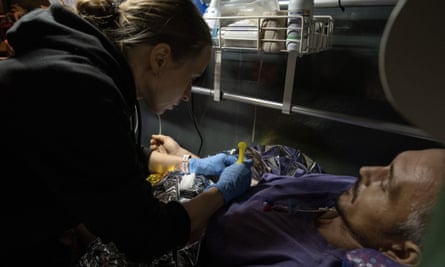Trump calls for ‘immediate ceasefire’ in Ukraine after meeting Zelenskyy

By Guardian-Shaun Walker in Kyiv - Sun 8 Dec 2024 15.08
US president-elect claims Kyiv ‘would like to make a deal’ to end war with Russia and cites loss of ‘400,000 soldiers’. Donald Trump has called for an immediate ceasefire in Ukraine, a day after meeting the Ukrainian president, Volodymyr Zelenskyy, in Paris, claiming Kyiv “would like to make a deal” to end its war with Russia.
In a post on his Truth Social platform, Trump said both sides had suffered enormous losses in the war – which he claimed on the US election campaign trail he would be able to end “in 24 hours” if elected. Trump has already appointed the retired army general Keith Kellogg as his Russia and Ukraine envoy, tasked with ending the war.
“There should be an immediate ceasefire and negotiations should begin. Too many lives are being needlessly wasted, too many families destroyed,” Trump said on Sunday.
He said Kyiv had “ridiculously lost 400,000 soldiers, and many more civilians”. He did not specify whether the figure included those wounded. “Zelenskyy and Ukraine would like to make a deal and stop the madness,” he added.
Zelenskyy wrote on Telegram on Sunday that he had had a “good meeting” with Trump in Paris. The news site Axios reported that the French president, Emmanuel Macron, had persuaded Trump to meet Zelenskyy with him, Trump being initially reluctant to meet the Ukrainian leader.

Zelenskyy said on Sunday that 43,000 Ukrainian soldiers had been killed and 370,000 wounded, of whom about half had been able to return to service after treatment.
Russia and Ukraine have both been reluctant to publish figures of those killed or wounded in action. In February, Zelenskyy gave a figure for the first time, putting the number of those killed at 31,000. At the time, western estimates put the real figure closer to 70,000 military fatalities.

How Trump’s policy on Ukraine will look in practice remains something of a mystery. Kellogg has previously talked of putting pressure on Kyiv and Moscow to enter talks, and boosting military aid to Ukraine if Vladimir Putin refused to engage. Others in Trump’s orbit have espoused openly pro-Russian views.
There has been cautious optimism in Kyiv over Trump’s election, as many Ukrainians felt the red lines and “escalation management” of the Biden administration had disastrous consequences on the battlefield.
Ukraine has become increasingly exhausted after nearly three years of full-scale war, and the number of people who say they would consider territorial concessions to stop the conflict is increasing.
“About a third are against any deal, a third want a deal in any circumstances including through concessions to Russia, and a third are not sure. They want the war to end but not at any price,” said the political analyst Volodymyr Fesenko in an interview in Kyiv.

In recent months, Kyiv has been suffering from an acute personnel shortage as its mobilisation drive flounders and the army struggles to replenish ranks. This has led to the US administration making the unusual move of publicly calling on Kyiv to lower the mobilisation age from 25 to 18 years old. Zelenskyy has ruled out the move, which would be deeply unpopular in Ukrainian society.
Among Zelenskyy’s inner circle, there is an increasing awareness that, as the army struggles to hold back Russia on the frontline, some kind of negotiations will be necessary soon. But they fear that without solid security guarantees from the west, a ceasefire would be meaningless.
“I told [Trump] that we need a just and strong peace, which the Russians won’t destroy in a few years as they did before,” Zelenskyy said on Sunday.
Despite Trump’s optimism about a possible deal, it is not clear that Putin has any interest in negotiations at the moment. He has laid out his demands for ending the war, which include Russian control over the Crimean peninsula and four regions Moscow laid claim to in 2022, including parts of Ukraine not currently controlled by Russian troops. Putin also wants a ban on Ukraine joining Nato, as well as its disarmament. Most of these conditions would be absolutely unacceptable for any Ukrainian leader to sign.
In recent weeks, a number of sources close to decision-making circles in Moscow have told the Guardian that they did not see any desire on Putin’s part to make real concessions for the sake of peace. “So far, I’ve seen no indications, either privately or publicly, that Moscow is particularly flexible in its stance. Those signals simply haven’t been there,” said one source in the Russian foreign policy establishment.